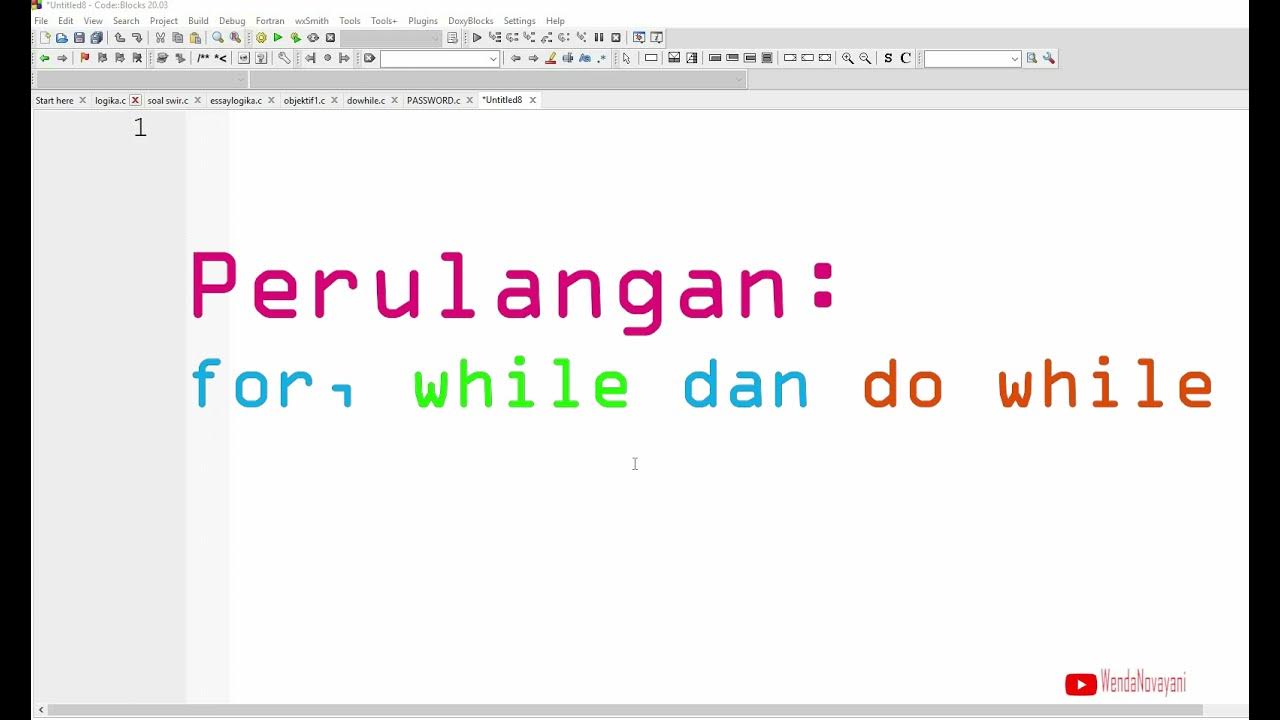Perulangan FOR (Looping For)
Summary
TLDRThis video introduces the 'for' loop in programming, explaining how it differs from 'while' and 'do-while' loops. The 'for' loop is used when the number of iterations is known, allowing for initialization, condition checking, and updating of variables in a concise manner. The video demonstrates practical examples of how the 'for' loop operates in Java, walking through the steps of initialization, condition checks, incrementing, and printing outputs. Viewers are encouraged to try coding examples in Eclipse to better understand the loop's behavior.
Takeaways
- 😀 The 'for' loop is used for looping a known number of times, unlike the 'while' and 'do-while' loops, which are used when the number of iterations is unknown.
- 😀 The 'while' loop checks the condition before entering the loop, while the 'do-while' loop checks the condition after the loop has run once.
- 😀 The 'for' loop has three main parts: initialization, condition check, and increment/decrement operation.
- 😀 The flowchart for a 'for' loop involves initializing a variable, checking the condition, executing the loop body if true, incrementing/decrementing the variable, and repeating until the condition fails.
- 😀 To write a 'for' loop, the syntax includes: initialization, condition selection, and increment/decrement operation after each iteration.
- 😀 Example 1: For x = 4, the loop will print values 4, 5, and 6, then stop when x reaches 7.
- 😀 Example 2: For x = 4, the loop will print 4 and 6 and stop when x reaches 8, as the condition x < 7 is no longer true.
- 😀 Example 3: For a variable j starting at 2, the loop will print values from 5 to 10, with j incrementing by 1 each time and the printed value being j + 3.
- 😀 The 'for' loop is ideal when the number of iterations is predefined or when the loop control variable has a clear increment or decrement pattern.
- 😀 The provided examples highlight the importance of understanding how to initialize variables, check conditions, and manipulate the loop variable to control loop execution.
Q & A
What is the main difference between 'for' loops and 'while' or 'do-while' loops?
-'For' loops are typically used when the number of iterations is known in advance, whereas 'while' and 'do-while' loops are used when the number of iterations is not predetermined.
How does the flow of a 'for' loop work?
-In a 'for' loop, the initial value is set, a condition is checked, and if the condition is met, the loop body executes. Afterward, the loop's control value is modified (increased or decreased), and the condition is checked again until it is no longer true.
What happens when the condition in a 'for' loop is no longer met?
-When the condition is no longer met, the loop exits, and the program continues to the next block of code after the loop.
Can you explain the structure of a 'for' loop?
-A 'for' loop consists of three parts: initialization (setting an initial value), condition (a test to control the loop), and the increment/decrement operation (to modify the control value after each iteration).
In the given example, what is the output when the initial value of x is 4 and the condition is 'x < 7'?
-The output will be 4, 5, and 6. The loop starts with x = 4, and after each iteration, x is incremented by 1, with the values printed on the screen as long as x is less than 7.
What happens after x becomes 7 in the example with the condition 'x < 7'?
-When x becomes 7, the condition 'x < 7' fails, and the loop exits. No further values are printed, and the program continues.
In the second example, where x is initially 4 and increases to 8, what values are printed?
-The values printed are 4 and 6. After x is incremented from 4 to 6 and printed, it increases to 8, where the condition 'x < 7' fails, so the loop exits.
What is the output of the loop when the initial value of j is 2 and the condition is 'j <= 7'?
-The output will be 5 and 8. The value of j starts at 2, and in each iteration, the loop increments j by 3, printing j + 3 each time until j becomes greater than 7.
What is the purpose of increasing or decreasing the value in a 'for' loop?
-Increasing or decreasing the value in a 'for' loop is necessary to ensure the loop eventually exits. This change in the loop variable controls the flow of iterations and ensures the condition will eventually fail.
How do you know when to use a 'for' loop instead of a 'while' or 'do-while' loop?
-Use a 'for' loop when the number of iterations is known beforehand, as it allows for concise initialization, condition checking, and value modification all in one line. Use 'while' or 'do-while' when the number of iterations is uncertain or depends on dynamic conditions.
Outlines

Esta sección está disponible solo para usuarios con suscripción. Por favor, mejora tu plan para acceder a esta parte.
Mejorar ahoraMindmap

Esta sección está disponible solo para usuarios con suscripción. Por favor, mejora tu plan para acceder a esta parte.
Mejorar ahoraKeywords

Esta sección está disponible solo para usuarios con suscripción. Por favor, mejora tu plan para acceder a esta parte.
Mejorar ahoraHighlights

Esta sección está disponible solo para usuarios con suscripción. Por favor, mejora tu plan para acceder a esta parte.
Mejorar ahoraTranscripts

Esta sección está disponible solo para usuarios con suscripción. Por favor, mejora tu plan para acceder a esta parte.
Mejorar ahoraVer Más Videos Relacionados
5.0 / 5 (0 votes)






